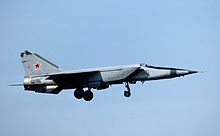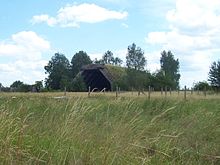Werneuchen Airfield
| Werneuchen Airfield | |
|---|---|

|
|
| Characteristics | |
| ICAO code | EDBW |
| Coordinates | |
| Height above MSL | 80.2 m (263 ft ) |
| Transport links | |
| Distance from the city center | 1 km east of Werneuchen , 20 km northeast of Berlin |
| Street | B 158 |
| Basic data | |
| opening | November 27, 1937 |
| operator | Flugplatz Werneuchen GmbH |
| Start-and runway | |
| 08/26 | 1499 m × 28 m concrete |
The airfield Werneuchen is east of Berlin situated airfield in Werneuchen in Brandenburg .
It is classified as a special landing site and is mainly frequented by ultralight aircraft . The maximum take-off weight is 5.7 t. The frequency of the airfield is 128.740 MHz.
history
time of the nationalsocialism

The airfield was built as a training facility for the Luftwaffe from 1935 after the Reich Aviation Ministry had acquired the site in the same year . Construction of the actual facilities began in the spring of 1936 and was completed in November of the following year. On November 27, 1937, was a garrison of the Wehrmacht officially inaugurated and the Jagdfliegerschule Werneuchen passed. On May 20, 1940, the unit was renamed Fighter Pilot School 1 , before it was named Jagdgeschwader 101 at the end of 1942 and relocated to southern France on April 1, 1943 after the school was closed.
In preparation for the attack on Poland , parts of KG 26 were relocated to Werneuchen in August 1939 , and parts of KG 27 also used the space at the beginning of September 1939 as a starting point for bombing operations. In March 1942 the IV./JG 1 was erected and subsequently relocated to Döberitz .
From 1943, night hunting units such as parts of the NJG 5 were stationed in Werneuchen again and again . Various hunting and slaughter units were added later, which flew missions against the Soviet troops on the Oder , especially in January / February 1945 . In November / October 1943, tests with the FuG 200 radar device were carried out on site by the test squadron for anti-ship combat .
On April 20, 1945 units of the Red Army occupied the airfield after the remaining ground units had fled. This was followed by the stationing of the 241st Bombing Division (BAD), equipped with Pe-2 , which flew missions against targets in and east of Berlin and in the Beeskow area in the last days of the war.
Post War and Cold War
After the Second World War , the Soviet Army continued to use the airfield as part of the 16th Air Army . From 1947 onwards the Pe-2 front bombers of the 24th, 779th and 985th Bombing Regiments (BAP) were stationed. In 1949 the staff command squadron of the 20th Guards Troop Army (Gw OA) was added, which consisted of the 41st Independent Mixed Fliegerstaffel (OSAE) set up on May 1st of that year. She moved to Oranienburg in 1968 , but returned to Werneuchen in 1990 as the 41st Independent Helicopter Squadron (OWE) and stayed here until the Soviet troops withdrew in 1993. The 41st OWE was the last Soviet unit in Germany to carry the Mi-2 flew.
In 1951/1952 the first extensive expansion of the square took place, including the remaining German infrastructure. Among other things, a concrete runway of 2500 × 80 m was created. From 1953 the first IL-28 jet bombers were stationed. A year later, the staff of the 132nd BAD and with it the subordinate 63rd and 668th BAP, which were also equipped with the IL-28, moved to the field, the latter moving to Brand two years later . The 63rd BAP was later converted to the Jak-28 . In 1968 he was moved to Chernyakhovsk . The front bomber units were replaced in 1968/1969 by the 931st Independent Guard Reconnaissance Air Regiment (Gw ORAP), mainly equipped with Jak-27 and Jak-28 .
Werneuchen was also used again and again for the short-term stationing of long-range bombers , around 1955/1956 of Tu-4 or more often of Tu-16 . Transporters such as the IL-14 and An-12 also flew to the field. In August 1957, a Tu-104 landed with the Soviet party leader Nikita Khrushchev on a state visit to the GDR in Werneuchen.
From March to October 1971 Werneuchen was expanded again. Among other things, a special weapons store of the Granit-2 type was set up for the storage of nuclear weapons. The construction of an underground tank system under the flight line was one of the extensions carried out in 1973/1974 to enable the stationing of MiG-25 reconnaissance vehicles, which took place from 1974. The MiG-25s of the 931st OGwRAP stayed in Werneuchen until 1991, where, after the political upheaval, a machine of this type could be viewed for the first time in Germany at an open house on May 1, 1991.
On May 21, 1991 the 931st OGwRAP was disbanded, the remaining MiG-25s were transferred to Neu-Welzow , where they formed the third squadron of the 11th ORAP and were finally relocated to Russia in early July. The airfield was handed over to the Federal Property Office in Frankfurt (Oder) in September 1993 after the last material shipment flights by IL-76 and An-22 transporters , after it had already been released for civil use the year before.
Post-turnaround time
Since the fall of the Wall and the withdrawal of the Soviet troops, the square has been used for civilian purposes. Due to the low traffic volume of less than 1000 take-offs and landings per year, the meadows on the area of the airfield are used for sheep farming.
Due to illegal car races on the square and also on the runway, the runway was divided to prevent this in the future. For this purpose, an approx. 0.7 m high earth wall was heaped up, which divides the railway into a 900 m long western section and a 1499 m long eastern section. Only the eastern section is permitted for flight operations.
The aeroclub "Melli Beese" e. V. and the ultralight flight school Rosemann are active on the historic square with training flights. In addition, the space is used by numerous private pilots in the north and south. The airport is also regularly served by Comair , a business airline of the Berger Group, with twin-engine jets. Since 2007 the special airfield has been the main base of the Europe-wide active aerial photo agency euroluftbild.de, which has stationed several single-engine aircraft here.
traffic
The Werneuchen airfield is located directly on the B 158 approx. 18 km outside the Berliner Ring with a connection to the Niederbarnimer Railway .
Incidents
- On July 10, 2002, the heaped earth wall (see above in the section after the turning point) was the undoing of an aircraft operated by the Swiss airline Swiss . The aircraft of the type Saab 2000 with the aircraft registration HB-IZY touched down on the western part of the runway, lost the landing gear when rolling over the earth wall and had to be written off as a total loss. One passenger was slightly injured. Previously had Swiss-flight LX 850 on the way from the airport Basel to Hamburg Airport . Due to bad weather conditions, the crew canceled the approach to Hamburg Airport. Because of the strong storm front it seemed the fulfillment of an alternate airport Bremen impossible, they headed to holding patterns over Lübeck initially the Hanover Airport to gave way but then further east with destination Berlin from. After the weather conditions at Berlin airports had worsened dramatically during the onward flight and an alternative landing in Berlin-Tegel could not be carried out despite the dwindling fuel reserves , the crew decided to make an emergency landing in Werneuchen. Since she did not have any maps of the Werneuchen airfield, she was not aware of the existence of the earth wall.
- On August 12, 2004 a Beechcraft King Air business jet had an accident . All six people on board were injured in the accident. The aircraft had previously taken off in a westerly direction. Because of leaking fuel, the crew attempted an immediate landing. The aircraft crashed from a low height on a meadow at the eastern end of the runway.
- On June 10, 2019, an ultralight aircraft built in 1993 crashed shortly after take-off. The pilot died at the scene of the accident. The exact cause of the accident is not yet known.
literature
- Stefan Büttner: Red places. Russian military airfields Germany 1945–1994. Air bases – aerodromes – military fallow areas . AeroLit, Berlin 2007, ISBN 978-3-935525-11-4 .
- Lutz Freundt: Soviet Aviation Forces Germany 1945–1994. Airfields (part 2) and units . Edition Freundt, Diepholz 1998, ISBN 3-00-002665-7 .
- Johannes Mohn (Ed.): Werneuchen - the history of an air base in Brandenburg . Cologne 1998, ISBN 3-929574-05-5 .
- Jürgen Zapf: Airfields of the Air Force 1934–1945 - and what was left of them. Volume 1: Berlin & Brandenburg. VDM , Zweibrücken 2001, ISBN 3-925480-52-8 .
Web links
- Official website of Werneuchen Airport
- Werneuchen in the 30s
- Pictures from the Werneuchen airfield
- Panic when taking off: Werneuchen again ... - Report on the accident on August 12, 2004
Individual evidence
- ^ BfU investigation report on the incident of July 10, 2002
- ↑ Aircraft accident data and report Saab 2000 HB-IZY in the Aviation Safety Network (English), accessed on March 23, 2017.
- ↑ Investigation Report on the accident on 12/08/2004. BFU, April 2007, accessed on October 13, 2017 .
- ↑ Pilot died in a crash with a small airplane on rbb24.de, June 10, 2019.


